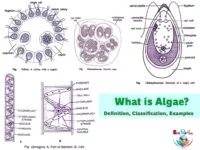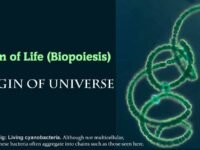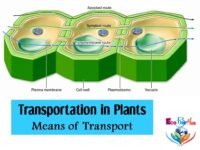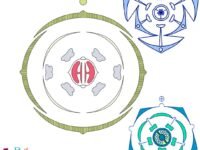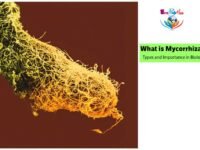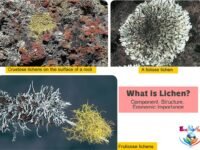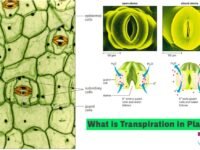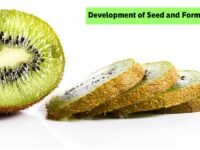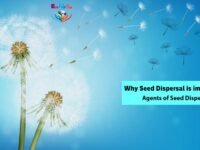In this tutorial, we have discussed ‘Origin of Life (Biopoiesis) and Origin of Universe’ including ‘Living and Nonliving‘ and many theories.
► Read More: Aerobic and Anaerobic Respiration in Plants ► Read More: What is ATP in Biology: Structure, Phosphorylation, Function ► Read More: Angiosperm Plant Families and their Floral Formula ► Read More: Stem Anatomy || Monocot and Dicot Stem Cross Section ||
TABLE OF CONTENTS
LIVING AND NONLIVING
All diverse things on this planet are divided into three kinds: living, nonliving and dead. Nonliving could mean either dead or inanimate. But these two terms are not equivalent. The essence of an organism lies in particular materials and building patterns or structures. Living beings are called organisms.
► Similarities Between Living Beings and Nonliving Objects
1. Living beings are basically made up of the same elements that constitute nonliving things.
2. These elements combine to form molecules (biomolecules in living beings).
3. Like the molecules of nonliving objects, the molecules of living beings are also capable of interacting.
4. Both living beings and nonliving objects are subjected to the same physical laws like gravitation, magnetism, action and reaction.
► Differences Between Living Beings and Nonliving Objects
Levels of Organisation
01. Living beings possess organic molecules whereas nonliving objects do not.
02. Living beings possess a number of macromolecules. These are complex molecules formed by condensation and interaction of smaller molecules or micromolecules.
03. All living beings possess genetic material in the form of DNA (rarely RNA). There is no such material in the inorganic world.
04. Molecules are organized as crystals, colloids, and mixtures in nonliving objects, whereas they form subcellular components in living beings.
05. In the living world, subcellular components are organized to form cells, cells into tissues, tissues into organs and the organs into organ systems and the organ systems into an individual. This type of organization does not occur in nonliving objects.
06. Differences at the molecular level between the living and the nonliving occurred very early in geological history.
07. Organisation has become more and more complex beyond the level of the individual.
08. A constant input of energy is required for the maintenance of living system but the nonliving objects do not require any input of energy.
09. Living beings constitute an open system with a regular intake of materials and excretion of wastes, whereas nonliving objects neither take raw materials nor produce wastes.
► Organisms Share Some Unified and Basic Characteristics
Living beings are unique because they present a characteristic level of organization. Inspite of diversity, organisms have many things in common.
● They are highly organized and complex entities formed of one or more cells.
● They carry out and control many chemical processes.
● They acquire and use energy for metabolism.
● They respond to changes in the environment and maintain a constant internal environment.
● They grow in size, develop and produce offspring similar to them.
● They adapt to environmental changes and gradually evolve into new types of organisms.
ORIGIN OF UNIVERSE
About 20 billion years ago, the universe was a single piece of highly condensed, red hot, rotating, gaseous cloud of cosmic dust, called primaeval or cosmic matter or yelm. The yelm consisted of particles of matter (like neutrons, protons, electrons) and antiparticles. The universe expanded and its temperature came down.
According to the big bang hypothesis proposed by Abbe Lemaitre (1931) and supported by Gamow (1948) and Dicke (1964), the particles and antiparticles collided and formed hydrogen atoms which fused into progressively heavier atoms of different elements. This was the beginning of cosmic evolution. The cosmic matter exploded by big bang or radionuclear explosion into numerous small and large masses of gaseous hydrogen, called nebulae.
A nebula is a cold and spinning cloud of cosmic dust. Due to spinning, it separated into numerous galaxies. A galaxy is a family of numerous stars, held together by mutual gravitational attractions. The huge star family to which our sun belongs is called the milky way. The mass seems to have blown apart with a “big bang” sometime between 12 and 14 billion years ago with around 150–200 billion stars and has been expanding ever since.
Galaxy is a specific arrangement of stars, e.g., the Milky Way. Our solar system is a part of a galaxy.
► Origin of Solar System and the Earth
According to the Nebular hypothesis, proposed by Kant (1755) and Laplace (1796), our solar system arose 4.6 billion years ago from a huge, red hot, spinning cloud of cosmic dust and gas containing millions of atoms of different types. The central mass of the nebula condensed to form the primitive sun. It gradually became hotter and brighter due to the conversion of gravitational energy into heat. Thermonuclear reactions started due to high temperature and the Sun then started emitting solar radiations.
Because of the rotational movement of the nebula, a peripheral ring of cloud got separated from the central mass, and condensed into planets: Mercury, Venus, Earth, Mars, Jupiter, Saturn, Uranus and Neptune. Initially, our Earth was a fiery spinning ball of hot gases and vapours of various elements. Through hundreds millions of years, the gases gradually condensed into a molten mass and different elements got stratified according to their density. Heavy elements like iron and nickel sank to the centre and formed the solid core of the earth, lighter elements such as silicon and aluminium rose to the surface and solidified to form earth crust. The part of the earth between core and crust formed mantle. The lightest ones like helium, hydrogen, oxygen, nitrogen and carbon flowed out of the surface and formed the gaseous atmosphere which was much different from what it is today.
Our Earth lies at a distance of 148.7 million km from the Sun. Its diameter is about 12,735 km and has a mass of 6 x 1612 tonnes. It is divisible into three parts: baryosphere, pyrosphere and lithosphere.
● Baryosphere is the core of the earth. It is formed mainly of nickel and iron, it is believed to be molten and is divisible into an inner core region with a radius of about 1280 km and an outer core region having a radius of about 2200 km.
● Pyrosphere is the mantle part of the earth having a radius of about 2,800 km. It is formed of elements like silica, aluminium, magnesium and manganese, which are lighter than iron and nickel.
● Lithosphere is the crust or surface layer of the earth. It is 20-25 km in thickness and is formed of rock basalt under the sea and granite in the continents.
The gaseous envelope around the earth is called atmosphere. It is about 1,600 km thick.
● The watery part on the surface of the earth is called hydrosphere. It covers 75-80% of the earth’s surface.
►Conditions on Primitive Earth
Immense heat would have been generated by the impact of meteorites and compaction by gravity, and young planet Earth probably began as a molten mass. The mass is then sorted into layers of varying densities, with the least dense material on the surface, solidifying into a thin crust.
As the bombardment of early Earth slowed about 4 billion years ago, conditions on the planet were extremely different from those of today. The first atmosphere was probably thick with water vapour, along with various compounds released by volcanic eruptions, including nitrogen and its oxides, carbon dioxide, methane, ammonia, hydrogen, and hydrogen sulfide. All of them existed in gaseous form while water formed superheated steam. Such an atmosphere is called reducing atmosphere.
As Earth slowly cooled, the water vapour condensed into oceans. Not only was the atmosphere of young Earth very different from the atmosphere we know today, but lightning, volcanic activity, and ultraviolet radiation were much more intense
01. Primitive Atmosphere: The original temperature of the earth is estimated to be 5,000-6,000°C. At such a high temperature, elements like hydrogen, oxygen, carbon and nitrogen could not exist in a free state. These combined either among themselves or with metals forming oxides, carbides and nitrides. As a result, carbon was found as carbon dioxide, cyanogen, methane and as metal carbides. Nitrogen existed in combination with metals to form nitrides, oxygen formed oxides, and hydrogen combined with oxygen forming water (H2O), combined with nitrogen forming ammonia (NH3) and combined with carbon forming methane (CH4) and carbon with nitrogen formed cyanides. The temperature was so high that all these compounds existed in the gaseous state and water as superheated steam. These formed the atmosphere of the primitive earth. Such an atmosphere was called reducing atmosphere by Oparin and Haldane.
02. Energy Sources: The energy sources on primitive earth were:
(a) Solar Radiations: There was no radiation belt around the earth. Therefore, solar radiations in the form of UV rays or infra-red rays reached the earth along with visible sunlight.
(b) Electric Discharge: Violent electric discharges were produced due to lightning and thunders across the sky of the primitive earth.
(c) Volcanic Eruptions: Frequent volcanic eruptions emitted energy in the form of heat.
(d) High temperature of primitive earth also contributed energy for chemical reactions.
(e) Cosmic rays from space (cosmos) also formed an energy source.
ORIGIN OF LIFE — BIOPOIESIS
(Abiogenesis and Biogenesis)
The earliest evidence of life on Earth comes from fossils that are about 3.5 billion years old. Origin of life on earth from inanimate matter is known as biopoiesis (Gk. bios = life + poiesis = production). Several theories have been given by various scientists to explain the origin of life e.g., theory of special creation, theory of eternity, theory of catastrophism, cosmozoic theory, theory of panspermia, Oparin- Haldane theory etc.
1. Theory of Special Creation
According to the theory of Special Creation, all the living plants and animals existing today were created by God or Creator. This theory was proposed by Hebrew et.al. and supported by Father Suarez (Spanish Priest).
➢ According to Christianity, Genesis of Bible has proposed that God created the whole world in six days from material prima. The heaven and the earth were created on the first day, sky and sea on the second day, dry land and plants on the third day, sun, moon and stars on the fourth day, fish and fowl on the fifth day and animals including man and beasts on the sixth day. The first man, Adam was formed from clay while the first woman, Eve, was created from his 12th rib.
➢ According to Hindu sastra Bhagwatam, the supreme personality of Godhead is Krishna (Adi Purusha). His Purusha Avatars are:
(i) Karanodakashayi Vishnu (Maha Vishnu) – “The Lord who is lying on the causal ocean”. Karanodakashayi Vishnu creates unlimited universes (also called Ananta).
(ii) Garbhodakasayi Vishnu – From Karanodakashayi Vishnu comes a Garbhodakashayi Vishnu for each universe. “The Lord who is lying on the universal ocean”.
(iii) Ksirosakasayi Vishnu – “The Lord who is lying on the ocean of milk”. From Garbhodakashayi Vishnu comes Brahma, the secondary material creator (who formed life), as well as Kshirodakashayi Vishnu, who Takes care of the maintenance of universes and enters every atom of each universe and is also known as the Supersoul, or Paramatma. Paramatma sits in the hearts of all living entities, giving direction to them in their material sojourn.
The first man was Manu and the first woman Shradha. This theory is not accepted by scientists because it is purely a religious concept, acceptable only on the basis of faith. It is not a scientific fact.
2. Theory of Catastrophism (Cataclysm)
According to this theory, the earth has undergone several catastrophes and each catastrophe (a sudden, extensive disaster or misfortune) destroyed life completely due to some geological disturbances.
After every catastrophe, God created a new living world that was quite different from the previous one. This theory is almost similar to the theory of special creation. Georges Cuvier (French scientist, 1769-1832) and Alcide d’Orbigny (1802-1837) were the chief advocates of this theory.
3. Theory of Eternity of Life (Steady-State Theory)
According to this theory, life existed in past and will continue to exist forever. It neither has a beginning nor an end. Throughout its existence, life has gradually changed in form. Again, this theory does not explain where life came on this earth. This theory was discarded because palaeontological evidences (presence or absence of a fossil) indicate the origin or extinction of the species represented.
But, the supporters of this theory did not accept such palaeontological evidences quoting the example of a coelacanth fish. Latimeria is a rare genus of fish that contains the only living species of coelacanth. According to fossil studies, Latimeia had been declared extinct but it was found living in oceans of Africa after several years. Scientists like Preyer, Helmholtz, Hoyle, Bondi believed that life is immortal i.e. eternal. Pluto, a supporter of this theory, stated that each species was an unchanging ideal form (eidos).
4. Cosmozoic or Interplanetary or Spore Theory (Theory of Panspermia)
Cosmozoic theory was proposed by Richter (1865) and supported by Arrhenius (1908). It is also called an interplanetary
theory. Richter, believed in the immortality of life like steady state theory but not in the stability of life forms.
This theory states that life in the form of resistant spores came to the earth from other planets along with meteorites and spaceships. Richter (1865) revived this theory and called these resistant spores panspermia. It was supported by Arrhenius (1908).
● Objections: The existence of life on any other planet is not known so far. Although in 1961, meteorites containing fossils of alga like microbes gave evidence for the existence of life on other planets, yet this theory was discarded.
Moreover, living matter cannot withstand the extreme cold and dryness and intense radiation of the cosmos while travelling to the earth. Finally, the theory does not explain how life originated.
There are evidences of life on some other planets and that life has come to the earth through meteorites. The remains of meteorites are found to contain fossils of algae. Space research has shown that bacteria can survive the rigour of space and can travel through airless and waterless environments. Francis Crick and L.E. Orgel have proposed that the earth was inoculated with organisms several billion years ago.
5. Theory of Abiogenesis / Spontaneous Generation / Autogenesis
Before the end of the seventeenth century, scientists and philosophers believed that living things originated abiogenetically from nonliving material. Empedoceles, Anaximander, Xenophanes, and Aristotle were the main propounders of this theory. According to Aristotle, insects developed from dew, frogs and Poads from the muddy bottom of ponds, butterflies from cheese, fly maggots from flesh and tapeworms from excreta of animals.
Van Helmont (1652) stated that young mice could arise from wheat grains in 21 days when these were put in a dark room with a moist dirty shirt. But, abiogenesis was experimentally rejected by Francisco Redi (1626–1698), Spallanzani (1765) and Pasteur (182-895), who proposed the theory of biogenesis. Redi, Spallanzani and Pasteur separately performed different experiments which conclusively showed that sterilized broth or flesh when sealed cannot give rise to life even when kept for several months. Life originated only when broth and flesh were contaminated by pre-existing life (living microbes, their spores present in air or eggs laid by flies etc).
6. Theory of Biogenesis (Life from Life)
According to biogenesis ‘Life can arise only from pre-existing life‘ and not from the nonliving matter by abiogenesis. This theory is supported by the following evidences:
01. Redi’s Experiment: Italian physician Francisco Redi demonstrated that maggots could not be created from meat, but the smell of meat attracted flies that laid eggs on the flesh. The maggots appeared when eggs hatched. Redi placed lumps of boiled meat in jars. Some jars were left uncovered. Some were covered with fine gauze or muslin cloth and others with parchment paper. The meat decayed in all the jars but maggots appeared only in the uncovered jars where flies could lay their eggs on meat.
02. Spallanzani’s Experiment: Italian scientist, Lazzro Spallanzani poured hay infusion in eight bottles and boiled all of them. Four of them were just corked and other four were made airtight. After a few days, he found that there was a thick growth of microorganisms in all the corked bottles but no organisms in the airtight bottles. He argued that air contains microorganisms and was the source of contamination.
03. Pasteur’s Experiment: French biochemist, Louis Pasteur, prepared hay infusion in swan necked flask. The infusion was boiled to kill the microbes present in the infusion and to make it sterile. Pasteur reported that such flasks remained free of life for over 18 months. But when the swan neck of the flask was broken and infusion came in contact with air, microbes appeared. Thus Pasteur proved that life comes only from pre-existing life.
BIOCHEMICAL OR CHEMOSYNTHETIC ORIGIN OF LIFE
The modern hypothesis of origin of life was formulated by Haeckel. His idea was elaborated in the chemical theory by two workers independently: a Russian biochemist A.I. Oparin in 1924 and an English biologist J.B.S. Haldane in 1928.
This theory is also called a naturalistic theory or Oparin-Haldane theory. It was summarized by Oparin in his book “The Origin of Life” published as an English edition in 1938. This theory (also termed as protobiogenesis theory) states that life originated from inanimate matter by a series of chemical reactions on the primitive earth.
A.I. Oparin (1923) and Haldane (1928) stated that life originated about 3.5 billion years ago from some nonliving organic compounds in the oceans of primitive earth through a series of chemical reactions. Four basic requirements for life to arise are – reducing atmosphere [with little or no oxygen, (O2)], an energy source, the right chemicals (including water, various inorganic ions and organic molecules); and infinite time. According to them:
01. Spontaneous generation of life (abiogenesis) under present conditions is not possible but could have occurred under the conditions prevailing in the reducing atmosphere of primitive earth which were favourable for chemical evolution. Earth’s initial atmosphere was of reducing type, much different from present day oxidising atmosphere.
02. High temperature, lightning and intense UV radiation provide the energy required for chemical reactions.
03. The abiotic (nonliving) synthesis of small organic molecules, such as amino acids and nitrogenous bases. The joining of these small molecules into polymers by polymerisation, such as proteins and nucleic acids.
04. The packaging of these molecules into “protocells,” droplets with membranes that maintained an internal chemistry
different from that of their surroundings
06. The origin of self-replicating molecules that eventually made inheritance possible.
Lederberg considered three stages in the origin of life: chemogeny, biogeny and cognogeny.
I. Chemogeny / Chemical Origin of Life (Abiotic Synthesis of Macromolecules)
About 4 billion years ago, the earth’s atmosphere had ammonia, methane and water vapours. There was no free oxygen. The formation of various simple and complex organic molecules from these gases is called chemogeny. It occurred in the following steps:
(i) Formation of Simple Organic Compounds
The primitive inorganic molecules interacted and combined to form simple organic compounds like alcohols, aldehydes, glycerol, fatty acids, amino acids, sugars and nitrogenous bases.
The synthesis of carbohydrates, fats and amino acids and other complex organic substances probably occurred in the sea, which had been described by Haldane as ‘The hot dilute soup’, or ‘prebiotic soup’ or ‘primitive soup‘ from which life arose.
(ii) Formation of Complex Organic Compounds
Simple organic molecules underwent condensation, polymerisation and chemical reactions forming new and complex organic macromolecules such as polysaccharides, fats, proteins, nitrogenous bases, nucleosides and nucleotides.
In living organisms, biological reactions are sped up by enzymes, but in the primitive sea, these enzymes were absent. So such reactions occurred far more slowly. Therefore, nature could synthesise all the compounds known to exist in present day living beings but at a very slow pace.
In the 1920s, Russian chemist A. I. Oparin and British scientist J. B. S. Haldane independently proposed that conditions on early Earth could have generated organic molecules. In 1953, Stanley Miller, then a graduate student in the laboratory of Nobel laureate Harold Urey, tested the Oparin – Haldane hypothesis. Miller devised the apparatus in such a way that a flask of warmed water represented the primaeval sea. (1) The water was heated up to 800oC so that some vaporized and moved into a second, higher flask. (2) The “atmosphere” in this higher flask consisted of water vapour, methane (CH4), ammonia (NH3) and hydrogen gas (H2), in They kept their experiment working continuously for 18 days. Miller identified a variety of organic molecules that are common in organisms, including hydrocarbons (long chains of carbon and hydrogen) and some of the amino acids such as glycine, alanine and aspartic acid that make up proteins. His results—the first evidence that the molecules of life could have arisen spontaneously from inorganic precursors-attracted global attention. Many laboratories have since repeated Miller’s classic experiment using various atmospheric mixtures and produced organic compounds. Recent evidence indicates that the early atmosphere may not have been as strongly reducing as once assumed. However, results from experiments using such atmospheres have also produced organic molecules, corroborating Miller’s results. And it is possible that small “pockets” of the early atmosphere—perhaps near volcanic openings—were reducing. In 2008, a former graduate student of Miller’s discovered some samples from an experiment that Miller had designed to mimic volcanic conditions. Reanalyzing these samples using modern equipment, he identified additional organic compounds that had been synthesized. Indeed, 22 amino acids had been produced under Miller’s simulated volcanic conditions, compared with the 11 produced with the atmosphere in his original 1953 experiment. (Miller had only found 5 amino acids using the analytical methods available to him at the time.) Scientists continue to generate alternative hypotheses for the origin of organic molecules on Earth. Some researchers are exploring the hypothesis that life may have begun in submerged volcanoes or deepsea hydrothermal vents, gaps in Earth’s crust where hot water and minerals gush into deep oceans. These environments, among the most extreme environments in which life exists today, could have provided the initial chemical resources for life. Another hypothesis proposes that meteorites were the source of Earth’s first organic molecules. Fragments of a 4.5-billion-year-old meteorite that fell to Earth in Australia in 1969 contain more than 80 types of amino acids, some in large amounts. Recent studies have shown that this meteorite also contains other key organic molecules, including lipids, simple sugars, and nitrogenous bases such as uracil. Chemical analyses show that these organic compounds are not contaminants from Earth. Research will continue on the possible origins of organic molecules on early Earth. (Ref: Campbell Biology Concepts Connections (10th Edition) by Martha R. Taylor, Eric J. Simon, Jean L. Dickey, Kelly A. Hogan, Jane B. Reece).
the ratio of 2 : 1 : 2 — the gases that scientists at the time thought prevailed in the ancient world. Electrodes discharged sparks into the flask to mimic lightning. (3) A condenser with circulating cold water cooled the atmosphere, raining water and any dissolved compounds back down into the miniature sea. (4) As material cycled through the apparatus, Miller periodically collected samples for chemical analysis.
(iii) Formation of Molecular Aggregates or Prebiotic Molecules
Oparin (1924) observed that if a heated mixture of a large protein and a polysaccharide is shaken, coacervates are formed. The coacervates contain mainly proteins, polysaccharides and some water. Oparin’s coacervates also show a simple form of metabolism. As these coacervates do not have lipid outer membranes hence they cannot reproduce. Thus they do not fulfil the requirement for probable precursors of life. When mixtures of artificially produced organic compounds are mixed with cool water
It is presumed that coacervates with proteins acting as enzymes and ATP as a source of energy were the first abiotic structures at the margin of nonliving and living. A similar reaction might have happened on early Earth, when waves splashed organic monomers onto lava or hot rocks and then rinsed polypeptides and other polymers back into the sea.
Sydney Fox (1950) heated a mixture of 18 amino acids to temperatures of 130 to 180ºC. He obtained stable, protein-like macromolecules which he named proteinoids. When the proteinoid material was cooled and examined under the microscope, Fox observed small spherical cell-like units that had arisen from aggregations of proteinoids. These molecular aggregates were called proteinoid microspheres. The first non-cellular forms of life could have originated 3 billion years back. They would have been giant molecules (RNA, proteins, polysaccharides etc.).
Proteinoid microspheres were spherical microscopic with about 1 to 2 mm in diameter, similar to the size and shape of coccoid bacteria.
Under an electron microscope, concentric double-layered boundaries around them have been observed through which diffusion of material occurs. They have the ability of motility, growth, binary fission and a capacity of reproduction by budding and fragmentation.
According to the rule of thermodynamics, organic molecules cannot accumulate in solution in large numbers because they break up as fast as they are built up. Scientists presume that these organic macromolecules accumulated on the charged surfaces of mud or clay or minerals in the underwater rocks. The clay and mineral molecules brought the organic molecules together and also provided a catalytic surface for continuous chemical reactions and the formation of amino acid polymers and of RNA nucleotide polymers. These reactions were comparatively faster than the reactions occurring in the hot dilute soup
Organic molecules, thus formed could accumulate in the primitive ocean forming hot dilute soup because: ● Absence of Oxygen: Due to the absence of free oxygen on the primitive earth, the organic molecules could remain unspoiled and reacted to produce new and more complex organic compounds. Thus, reducing atmosphere of primitive earth played important role in preserving these compounds. ● Absence of Living Beings: The organic compounds formed on primitive earth accumulated because there were no living forms to consume them. Such organic molecules could not accumulate today because an enormous number of microorganisms use and degrade them.
II. Biogeny / Biotic Origin of Life / Biological Evolution (Formation of the First Cell)
The biogeny or life from nonliving chemical compounds involved two main steps:
(i) From coacervates to the first primitive living system, i.e., the origin of protocells or eobionts or protobionts.
(ii) From protocells to first living cells.
(i) Origin of Eobionts or Protobionts
Laboratory experiments have shown that short RNA molecules can assemble spontaneously from nucleotide monomers. Furthermore, when RNA is added to a solution containing RNA monomers, new RNA molecules complementary to parts of the starting RNA sometimes assemble. (1) RNA monomers adhere to clay particles and become concentrated. (2) Some monomers spontaneously join, which form the first small “genes.” (3) Then an RNA chain complementary to one of these genes assembles. If the new chain, in turn, serves as a template for another round of RNA assembly, a replica of the original gene results.
This replication process could have been aided by the RNA molecules themselves, acting as catalysts for their own replication. The discovery that some RNAs, called ribozymes, can carry out enzyme-like functions and be able to make up their complimentary copies from ribonucleotides.
Inside the coacervates, the nucleotides might have combined to form nucleic acids, RNA and then DNA. Later on, the association of proteins and nucleic acids resulted in the formation of nucleoproteins.
The synthesis of nucleic acids and nucleoproteins marked the beginning of genetic material. With the formation of nucleic acids and the surface membrane, the coacervates changed into the first living system, called the protocells or eobionts or protobionts.
On early Earth, some vesicles with self-replicating, catalytic RNA differs from other vesicles without RNA. Being capable of replication, it forms a protocell. In 2013, researchers succeeded in constructing a protocell enclosing RNA that could self-replicate within the vesicle. Natural selection might have operated on such protocells, encouraging multiplication of those, which could exploit resources effectively and pass their abilities on to subsequent generations. Mutations, errors in copying RNA “genes,” would result in an additional variation on which natural selection could work. At some point during millions of years of selection, DNA, a more stable molecule, replaced RNA as the repository of genetic information, and protocells passed a fuzzy border to become true cells. The stage was then set for the evolution of diverse life forms.
(ii) Formation of Early Cells
The first cell probably arose from these protobionts and acted as ancestors to present day prokaryotes and eukaryotes.
01. Monerans (i.e., the cells without well defined nucleus) evolved into prokaryotes like bacteria and cyanobacteria. These lacked the nuclear membrane. Therefore, their nuclear material (DNA) was not isolated from the surrounding cell cytoplasm.
2. Protistans (the cells with distinct nucleus) had a nuclear membrane around their genetic material. This membrane isolated genetic material from cell cytoplasm. From protistans arose eukaryotes which evolved into Protozoa, Metazoa and Metaphyta.
It has been proposed that RNA evolved first as the hereditary material. DNA developed as a more stable hereditary material much later. Next, a coding system was developed and RNA became specialised to carry out three different functions in protein synthesis and three types of RNAs evolved. Later on, DNA developed the ability to mutate, resulting in the diversification of living cells.
III. Cognogeny (Evolution of Mechanism of Perception, Expression & Communication)
Cognogeny involves the diversification and evolution of the prokaryotic and eukaryotic cells. The early cells evolved three methods of obtaining energy and thus, evolved into the following types:
(i) Evolution of Prokaryotes
01. Chemoheterotrophs: It is presumed that first formed living cells were anaerobic and chemoheterotrophic and obtained energy by the fermentation of complex organic substances available to them from the sea broth. These multiplied rapidly due to abundant nutrient supply. Rapid proliferation of chemoheterotrophs gradually exhausted nutrients from seawater. Thus, several other nutrition modes like parasitism, saprophytism, predation, chemoautotrophism etc., developed. Nutrients were exhausted because temperature of the ocean and earth had cooled down further. Thus, conditions suitable for the fresh synthesis of those nutrients were not present. Besides, their synthesis rate was very much slower than the rate of their consumption.
2. Chemoautotrophs: In course of time, the food supply became depleted and some of the chemoheterotrophs evolved as anaerobic chemoautotrophs. They started synthesising their food from inorganic compounds in the presence of chemical energy produced by the degradation of inorganic compounds. These chemoautotrophs or chemosynthetic organisms include sulphate reducing bacteria, iron bacteria and nitrifying bacteria.
3. Photoautotrophs: As a chance event, in some anaerobic chemoautotrophs, chlorophyll appeared. This enabled them to synthesise their food from carbon dioxide and water utilising solar energy. This was the evolution of photosynthesis and the appearance of photosynthesisers. These forms were called photoautotrophs. In an environment where there was a shortage of inorganic compounds as a source of energy, the photoautotrophs were at a great advantage.
The first photoautotrophs were anaerobic. They did not use water as a hydrogen source. They used hydrogen sulphide, thiosulphate or hydrogen instead of water. Hydrogen was used in the synthesis of organic compounds (food) and sulphur was released as a waste product. They evolved about 3,500–3,800 million years ago.
The first oxygenic and aerobic photoautotrophs were cynobacteria or blue-green algae-like organisms. They used water as the source of hydrogen and carbon dioxide as the source of carbon in photosynthesis.
These released free oxygen in the atmosphere and are also called oxygen producing photosynthesisers. These appeared about 3300 to 3500 million (3.5 billion) years ago.
 The oxygen evolved by them probably dissolved in the surrounding water. Once water of sea and lakes became saturated with oxygen, free oxygen started accumulating in the atmosphere. During the period of 2.7 to 2.3 billion years ago, atmospheric oxygen increased gradually and then shot up to present day level. This is called Oxygen Revolution. It had an enormous impact on the evolution of life.
The oxygen evolved by them probably dissolved in the surrounding water. Once water of sea and lakes became saturated with oxygen, free oxygen started accumulating in the atmosphere. During the period of 2.7 to 2.3 billion years ago, atmospheric oxygen increased gradually and then shot up to present day level. This is called Oxygen Revolution. It had an enormous impact on the evolution of life.
With the increase of photoautotrophs, oxygen was liberated in the sea and then into the atmosphere. This free oxygen then reacted with methane and ammonia present in the primitive atmosphere and transformed them into CO2 and free N2.
The earth’s atmosphere changed from a primitive reducing atmosphere to a modern oxidising atmosphere with plenty of free oxygen. The rising level of atmospheric oxygen led to the appearance of the first one-celled eukaryotic organisms.
■ Impact of Photosynthesis
Cyanobacteria synthesised their organic food from carbon dioxide and water using solar energy which was converted into chemical energy entrapped in the organic compound, glucose, and released oxygen as a byproduct. The aerobic forms started using free atmospheric oxygen in oxidising the organic compounds. This resulted in the evolution of the respiratory mechanism. The carbon dioxide that evolved during respiration was utilised in photosynthesis. This ensured:
01. Regular inflow of energy in the biosphere.
02. Changed the atmosphere from reducing to oxidising.
03. Evolved method of utilising carbon dioxide and converting it to sugar.
In 1966, fossils of Archaebacteria were found in 3.2 billion years (3,200 million years) old rocks from Africa. They were cyanobacteria-like organisms and are named Archaeo-spheroides barbetonensis.
Palaeobotanists of Birbal Sahni Institute of Palaeobotany, Lucknow have obtained fossils of cyanobacteria from India which were estimated to be 2,900 million years old. Fossils of filamentous and colonial forms of cyanobacteria have also been obtained from western Australia.
■ Formation of Ozone Layer (Ozonosphere)
An ozonosphere developed by the reaction of oxygen under the influence of UV radiations:
O2 + 2O2 → 2O3 (Ozone)
Accumulation of the ozone layer in the atmosphere formed a protective layer that acts as a radiation belt. It protects the earth and life from high energy UV radiation.
■ Oxygen Revolution and Formation of Present Day Atmosphere
The evolution of oxidising atmosphere resulted in oxygen revolution and put an end to abiotic synthesis because the organisms consumed and degraded intermediate products formed abiotically. The oxygen revolution resulted in the evolution of new forms.
■ Impact of Free Oxygen
Free oxygen in the atmosphere finally led to the evolution of the aerobic mode of respiration which yielded more energy on oxidation of food stuffs as compared to anaerobic respiration.
➢ The modern atmosphere does not contain methane and ammonia as present in primitive earth’s atmosphere.
➢ The modern atmosphere contains water vapours, CO2, molecular nitrogen, hydrogen and free molecular oxygen.
Since oxygen was used in respiration for energy release, the green autotrophs became the source of food for nongreen heterotrophs. Thus, photosynthesis and respiration act as nature’s main balancing mechanisms.
These early prokaryotes were earth’s sole inhabitants from 3.5 billion years ago to about 2.1 billion years ago.
(ii) Evolution of Eukaryotes (Forms with True Nucleus)
■ Origin of Single-Celled Eukaryotes
The oldest widely accepted fossils of eukaryotes are about 1.8 billion years old (the orange band). The more complex eukaryotic cell originated when small prokaryotic cells capable of aerobic respiration or photosynthesis took up life inside larger cells. After the first eukaryotes appeared, a great range of unicellular forms evolved, giving rise to the diversity of single-celled eukaryotes that continue to flourish today.
■ Origin of Multicellular Eukaryotes
Another wave of diversification followed: the origin of multicellular forms whose descendants include a variety of algae, plants, fungi, and animals. The oldest-known fossils of multicellular eukaryotes are of relatively small algae that lived 1.2 billion years ago (the light blue band).
Larger and more diverse multicellular organisms do not appear in the fossil record until about 600 million years ago. A great increase in the diversity of animal forms occurred 535-525 million years ago, during a span of time known as the Cambrian explosion (the bright blue band).
Protocells were prokaryotic and somewhat like archaebacteria. Eukaryotes are regarded to have evolved from them either by (a) symbiotic origin or (b) by invagination.
(a) Endosymbiotic Origin
According to Lynn Margulis of Boston University, some anaerobic predator host cells engulfed primitive aerobic bacteria but did not digest them.
The oxygen respiring bacteria established themselves permanently inside host cells and developed mutual association. Such predator host cells became the first eukaryotic cells.
The predators that captured both aerobic bacteria as well as photosynthetic blue-green algal cells evolved into eukaryotic plant cells. The aerobic bacteria established themselves as mitochondria and blue-green algae as chloroplasts.
(b) Origin by Invagination
According to this view organelles of eukaryotic cells might have evolved by invagination and then cutting off of the surface membrane of a primitive prokaryotic cell.
Now, scientists believe that eukaryotic cells have evolved from prokaryotic cells by a combination of the above two processes e.g., nucleus and ER (endoplasmic reticulum) evolved by invagination of cell membrane while mitochondria and chloroplasts by endosymbiosis
(c) Origin of Multicellularity
Once unicellular organisms were formed, the cells aggregated to form colonies. Later, division of labour and cell differentiation led to the evolution of multicellular organisms, which diversified into various groups of Metazoa and Metaphyta or Animal and Plant kingdoms respectively.
This method of formation of complex forms of life from simpler ones by gradual change is called organic evolution.
The oldest fossils of Archaebacteria were 3.2 billion years old. They resembled simple prokaryotic cyanobacteria-like organisms. They are still represented by a few living groups existing today in conditions that match with those of primitive earth. These groups are: ● Methanogens produce methane and occur in the flora of cattle rumen. ● Halophiles utilise light energy, produce ATP but cannot convert CO2 to sugar. They occur in salt rich areas ● Thermoacidophils occur in hot sulphur springs at a temperature of 80ºC and oxidise sulphur to sulphuric acid.
COLONIZATION OF LAND
There is fossil evidence that photosynthetic prokaryotes coated damp terrestrial surfaces well over a billion years ago. However, larger forms of life did not begin to colonize land until about 500 million years ago {the purple band).
Plants colonized land in the company of fungi. Even today, the roots of most plants are associated with fungi that aid in the absorption of water and minerals; the fungi receive nutrients in return.
The most widespread and diverse land animals are arthropods (particularly insects and spiders) and tetrapods (vertebrates with four appendages). Tetrapods include humans, but we are late arrivals on the scene-the human lineage diverged from other primates around 6 to 7 million years ago, and our own species originated about 195,000 years ago. If the clock of Earth’s history were rescaled to represent an hour, humans appeared less than 0.2 seconds ago!


